|
King Cobra
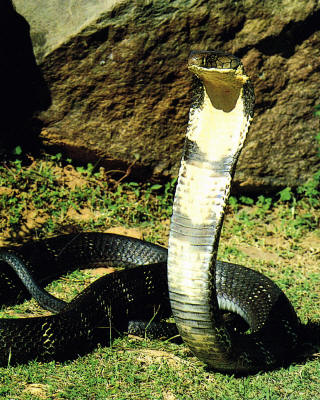
Every year
thousands of people in southern Asia die from poisonous snake bites.
Both people and other poisonous snakes live in fear of the king cobra, one
of the most deadly snakes of all.
The king cobra is the
longest of all the venomous snakes, and its bite is lethal.
It has been known to kill a person in 15 minutes, but despite this, the
king
cobra is really a shy, secretive animal and will avoid a fight if it can.
|
|
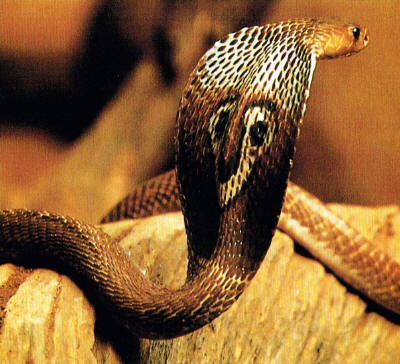
All cobra
species, including the Indian cobra
shown here, have highly poisonous venom.
HABITS
The king cobra is numerous in the dense highland forests of southern Asia
and has been found living at 6,500 feet above sea level in the mountains
of India. It is active by day and night, but it is rarely seen.
The king
cobra seems to prefer living near water, and if disturbed it will often
make its escape by slipping into a nearby stream and swimming away.
It is also a good climber and can pursue its prey into the trees if
necessary.
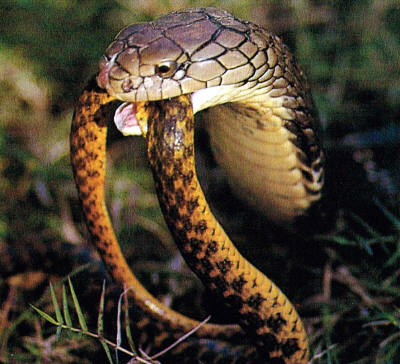
The king
cobra is one of the few snakes that
kills other snakes. It swallows its prey whole.
KING COBRA & MAN
The king
cobra's half-inch-long fangs are capable of delivering more venom than
those of any other snake except the gaboon viper.
The king cobra is most
aggressive when it is guarding its eggs. In India, if a nest is
found near a village, the area will often be evacuated.
Nevertheless, stories of enraged king cobras are probably exaggerated.
A king cobra with no eggs to defend will usually disappear into the
undergrowth if approached.
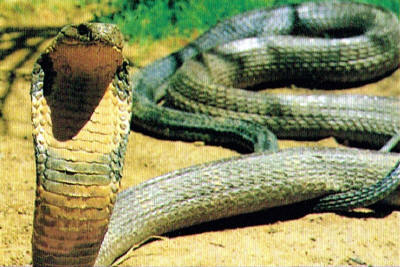
The king
cobra's venom attacks the nervous
system. The victim suffers pain, blurred vision
and dizziness. In 15 minutes, a victim can die.
|
BREEDING
The king cobra sheds its skin at the beginning of breeding season, and
in the female, molting triggers the release of a scent called a
pheromone
that attracts the male to her. The male entwines his body around the
female while they mate, and the pair may stay locked together for hours.
Male and female cobras are thought to pair for life, which is unusual in
snakes. They cooperate to find a nest site. The female lays
twenty to fifty white eggs in a hollow in the center of the nest, while
the male guards against predators.
A newly hatched king cobra is glossy black with pale yellow stripes, and
measures approximately 20 inches in length. It is able to hunt for
food almost immediately.
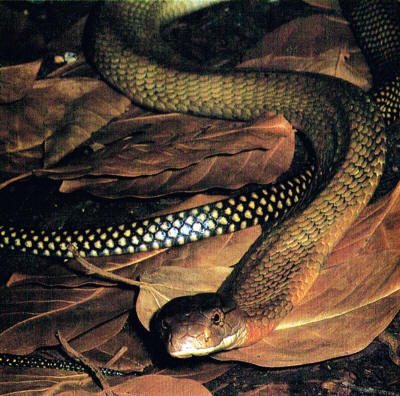
The king cobra lives in forest areas,
gliding silently through the undergrowth.
FOOD &
HUNTING
The king cobra is a
dangerous adversary. It will even attack pythons and highly venomous
snake species like the krait and other cobras, as well as large lizards.
It smells with its forked tongue, which it uses for tracking the scent of
its prey through the dense forest undergrowth. When the cobra gets
close to its prey, it relies on its eyesight to spot its victim before
striking it and subduing it with a massive dose of venom.
Having poisoned its
victim, the cobra swallows it while it is still struggling − this can be a
lengthy process. To make swallowing prey easier, the cobra's lower
jaws are composed of two independent bones that are loosely attached to
its skull; this allows the snake to swallow an animal that is
thicker than its own head.
The prey is slowly
drawn into the cobra's stomach by alternate movements of the snake's two
lower jawbones, while the snake's skin stretches to accommodate the bulk.
Swallowing large prey can take many hours, but the cobra will not eat
again for several weeks.
Interestingly, the
king cobra will often share its sleeping quarters with potential prey.
DID YOU KNOW?
●
A king
cobra can inject enough venom to kill a fully grown Indian elephant within
3 hours, provided it bites a sensitive spot such as the tip of the trunk.
●
Because of its slow metabolic rate, the king cobra can survive for months
without eating.
●
Snakes are deaf to most sounds, but they are sensitive to vibrations
transmitted through the ground and are easily frightened away by heavy
footsteps.
●
In Burma, king cobras are used in snake charming acts.
|


![]()
![]()